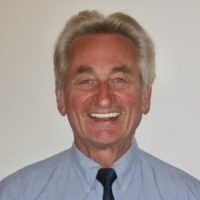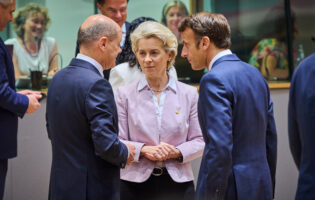Implications of the 2012 Election Results in North Rhine-Westphalia for the German Party System and the 2013 National Elections

Dieter Dettke
Georgetown University
Dr. Dieter Dettke is a Non-Resident Fellow at AICGS and Adjunct Professor at Georgetown University.
Dr. Dettke served as the U.S. Representative and Executive Director of the Friedrich Ebert Foundation in Washington from 1985 until 2006 managing a comprehensive program of transatlantic cooperation. In 2006, he joined the German Marshall Fund of the United States as a Transatlantic Fellow and from September 2006 to June 2007, he was a Fellow at the Woodrow Wilson International Center for Scholars. His most recent book is “Germany Says ‘No’: The Iraq War and the Future of German Foreign and Security Policy,” published by theWoodrow Wilson Center Press and The Johns Hopkins University Press, Washington, DC, and Baltimore, 2009.
Dr. Dettke is a foreign and security policy specialist, author and editor of numerous publications on German, European, and U.S. foreign and security issues.
He studied Law and Political Science in Bonn and Berlin, Germany, and Strasbourg, France and was a Fulbright Scholar at the University of Washington in Seattle in 1967/68.
North Rhine-Westphalia is a bellwether state for the Federal Republic of Germany and once again electoral results here seem to represent a new national trend. After less than two years as a minority government, the SPD-Green coalition under the leadership of Hannelore Kraft won the absolute majority of seats in the state legislature. Hannelore Kraft will now play a more prominent role on the national level. Furthermore, her name is now mentioned as a possible chancellor candidate for the SPD. But elected as a Minister President of Germany’s most populous state for the next five years, she will not want to move to Berlin even under the best political circumstances for the 2013 elections. Just a year after the North Rhine-Westphalia elections, such a move would hurt her hard won credibility in North Rhine-Westphalia as well as her role as a chancellor candidate against Angela Merkel. She will now be the most senior SPD leader in the Bundesrat, the powerful second chamber in the German legislative process where the states have a decisive say on national issues. Red-Green coalitions – in the case of Baden Württemberg a Green-Red coalition with a Minister President of the Green Party – have now a very strong position with 23 out of a total of 69 votes – 27 votes if a Red-Green and Danish minority party government will take over power in Schleswig-Holstein. CDU/CSU and FDP coalitions only have 21 votes in the Bundesrat altogether. The remaining 18 votes of the 69 total are states with a Grand Coalition of CDU and SPD. The ground rule for voting of grand coalitions in the Bundesrat is that they either have to come to an agreement or if not, abstain. Chancellor Merkel will have to adjust her political calculations to the new power constellation in the Federal Republic of Germany.
The Pattern of the Past
The Social-Liberal Era
In the past, multiple fundamental shifts of the power constellation on the national level first began to emerge in North Rhine-Westphalia before they reached the federal level. The first SPD-FDP coalition, the so-called social-liberal coalition model that dominated German politics both on the federal level as well as on the state level during the 1970s and 1980s, was first tested in North Rhine-Westphalia in 1968 before it became successful on the federal level, too. Political developments in North Rhine-Westphalia turned out to be the beginning of the social-liberal era in German national politics. It began in 1969 with the SPD-FDP coalition under the leadership of Willy Brandt and Walter Scheel and ended in 1982 when Helmut Kohl was able to replace Helmut Schmidt as Chancellor of the Federal Republic of Germany by way of a “constructive vote of no-confidence.” In 1982 it was the FDP, which switched sides in order to prevent losing its share of power on the national level as a result of an economic downturn and increasing political tensions in the context of a new Soviet nuclear threat and NATO’s military countermeasures. These two developments weakened the SPD on the national level so much so that the FDP began to fear for its survival if the party would continue to stay in a coalition with the SPD. In North Rhine-Westphalia, however, thanks to popular SPD leaders such as Johannes Rau, the SPD managed to stay in power even during the Kohl era.
The Red-Green Era
North Rhine-Westphalia’s bellwether role re-emerged in 1995 when, after years of an absolute majority of the SPD in this industrial and most populous state of the Federal Republic, the SPD needed a coalition partner in order to stay in power. Despite serious political differences, in particular over environmental issues in a state long dominated by its coal and steel industry, Minister President Johannes Rau entered a coalition with the Green Party. Three years later, the first SPD-Green majority in the German Bundestag allowed Gerhard Schröder to become chancellor in 1998. An earlier SPD-Green experiment in Hesse in 1985 only survived for less than two years. The Red-Green Coalition under the leadership of Gerhard Schröder and Joschka Fischer lasted until 2005. So far, it is the most successful SPD-Green model of governance in the Federal Republic of Germany.
Ringing in the End of the Red-Green Era
In 2005 North Rhine-Westphalia took on its bellwether role yet again, but this time as a fundamental shift away from the Schröder era and rang in the end of the SPD-Green coalition on the national level. When the SPD-Green coalition in North Rhine-Westphalia lost the 2005 elections in this crucial state, the consequences for the Red-Green coalition on the federal level were dramatic. Because of insufficient support in the Bundesrat, it was practically impossible for Schröder and Fischer to continue governing effectively. Instead of waiting out the electoral cycle in paralysis until 2006, Schröder pushed for early elections in 2005 and narrowly lost. The only viable political alternative was a Grand Coalition of CDU/CSU and SPD under the leadership of Angela Merkel. After seven years in office, and in a coalition government of CDU/CSU and FDP since 2009, Angela Merkel, after the 2012 elections in North Rhine-Westphalia, is now in a similar situation that Schröder faced in 2005. But it is highly unlikely that she, unlike Schröder in 2005, would push for new elections.
The Pattern of the Future
Even before the North Rhine-Westphalia elections the German party system was in ferment. The most important development is the weakening of the political center in Germany. SPD and CDU/CSU together used to be able to reach out to over 80 percent of the German voters. Today their share of the votes is just about 70 percent or less. But the erosion of the center was not necessarily beneficial for the extreme left and right wing parties. Fortunately, the extreme right is getting nowhere and the extreme left is on a serious downward trajectory. Rather, what happened in Germany is that the center has become more crowded. As a result of party inertia, a generous party financing system and few incentives for renewal and adjustment of the still dominant political parties in the center to new political, cultural, and economic developments, the Pirates seem to represent a non-party political party − a protest movement against the lack of modernization and adjustment to the new age of the internet and social media, greater individualization, and more transparency and political participation. Neither particularly left nor right, the new party is a welcome wake up call for the traditional German party system.
The Pirates
Out of nowhere, the Pirates entered state legislatures in Saarland, Berlin, and Schleswig-Holstein with well above the required 5 percent, and they were able to continue their rise to national power in North Rhine-Wesphalia as well. Founded only in 2006, they achieved 8.9 percent of the votes in Berlin, 7.4 percent in Saarland, 8.2 percent in Schleswig-Holstein, and now 7.7 percent in North Rhine-Westphalia. This development will inevitably make future coalition building in the Federal Republic of Germany more difficult. In North Rhine-Westphalia, the SPD and the Green Party were able to win the absolute majority of seats on their own. The new trend, however, seems to be a trajectory toward multiple coalition building involving more than two coalition partners, or producing more grand coalitions against all others. The 2013 German national elections could lead to such a situation.
The FDP
In 2009, with 13.8 percent of the vote, the FDP pulled off the best election result on the federal level in its entire history. The party was able to form its dream coalition with the CDU/CSU. After the elections, however, the FDP had to face a situation that led to a de facto collapse of its political hopes for the new right of center political model. The party had to stand by the coalition while its program, as well as its demands for the government’s political platform, were curtailed dramatically, almost obliterating its raison d’etre. All the shots were called by the larger and dominant coalition partner and adverse political and economic circumstances added to the plight of the FDP. Support for the FDP dropped to under 5 percent in several critical state elections and in public opinion polls on the national level, the trend pointed in the same direction. Even after recovering from earlier electoral defeats in recent state elections in Schleswig-Holstein and North Rhine-Westphalia, the FDP, because of the larger process of a diversifying center, has little chance of being able to obtain enough votes for a two party coalition on the right or on the left of the political spectrum of the Federal Republic of Germany.
Die LINKE
The downward trajectory of Die LINKE seems to continue mercilessly. With only 2.6 percent of the votes in North Rhine-Westphalia, the party had to face another depressing defeat in the western part of Germany. In theory, North Rhine-Westphalia could provide a strong working class base for the party. Right after World War II the then still legal communist party achieved excellent electoral results way over 10 percent. But during the Cold War, the German division, and the harsh reality of the GDR, the old communist party had little chance to survive in West Germany. More recently, Die LINKE could achieve a respectable election result in the Saarland. In 2009, the Saarland produced the best electoral result Die LINKE ever achieved. In the case of Saarland, it clearly was the extraordinarily strong personality of Oskar Lafontaine − a former SPD leader, long-time mayor of the city of Saarbrücken, as well as Minister President of Saarland − who made it possible for Die LINKE to achieve such an extraordinary result.
The real strength of the party is in eastern Germany where Die LINKE − as a successor party of the SED, later the PDS, and in West Germany the WASG (Wahlalternative Soziale Gerechtigkeit) as well as various pro and proto communist groups − was able to benefit from the pains of unification and attract a substantial number of voters. In Thüringen Die LINKE achieved 27.4 percent of the vote in 2009 − more votes than the SPD was able to get − forcing the state into a grand coalition government. Die LINKE or its predecessors were part of government coalitions in Berlin, Brandenburg, Mecklenburg-Vorpommern, and Saxony-Anhalt. It also achieved respectable results on the federal level, for example in 2009 with 11.9 percent and 76 seats in the German Bundestag. If Die LINKE were able to evolve and be capable of exerting a constructive force on the national level, a left majority in the Bundestag could at least, in theory, be established. However, this is out of the question in the foreseeable future. The party has learned to live comfortably in opposition, and it is living quite well on the basis of the German party financing regulations without ever seriously trying to govern. Members of the Bundestag enjoy not only a high standard of living, they are also in a position to get sufficient media attention in order to remain relevant, at least as the party that best represents the old “East” in Germany. If there is a long term chance for the party to survive on the national level it would be in a role similar to what the CSU represents for Bavaria. In the case of the Die LINKE, it would be for eastern Germany. But it will be exceedingly difficult for Die LINKE to play such a role because, other than in Bavaria, the individual states in eastern Germany have quite different interests and will, over time, develop different political profiles once the pains of unification are completely gone.
The Green Party
The FDP, Die LINKE and the Green Party – by now all established parties and part of the German party system – turned out, partially for reasons of complacency, to be unable to attract the new digital generation that now demands a place at the table in the name of democratic renewal. The extraordinarily fast transformation of the Green Party from a protest movement to a partner in government now seems to curb the most recent growth of the party with impressive electoral results both on the state and the federal level. With 11.5 percent in the 2012 elections in North Rhine-Westphalia, the party is clearly on the way into the establishment. However, it might have already peaked with the extraordinary electoral achievement in Baden-Württemberg in early 2012, when the Greens got 24.2 percent of the votes. They now provide their first Minister President of a major German state and will have to govern under very difficult political and economic conditions.
Conclusion
After the elections in North Rhine-Westphalia, the symptoms of a more diverse center and the likelihood of multiple party coalitions or, alternatively, more grand coalitions, are unmistakable. If Die LINKE continues to seek refuge in opposition, clear right or left majorities will be more difficult to achieve if the Pirates begin to occupy substantial room within the German political spectrum. In North Rhine-Westphalia, the extraordinary role of Hannelore Kraft as a leader led to a clear electoral victory and mandate for the left – as before in Baden-Württemberg. Nevertheless, whether these developments will ultimately point in the direction of identical trends on the national level is a different question. There is no automatism in politics.








